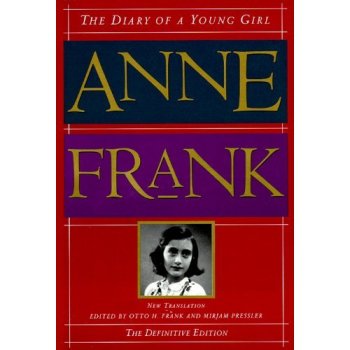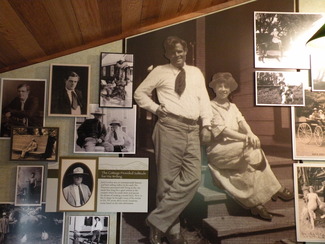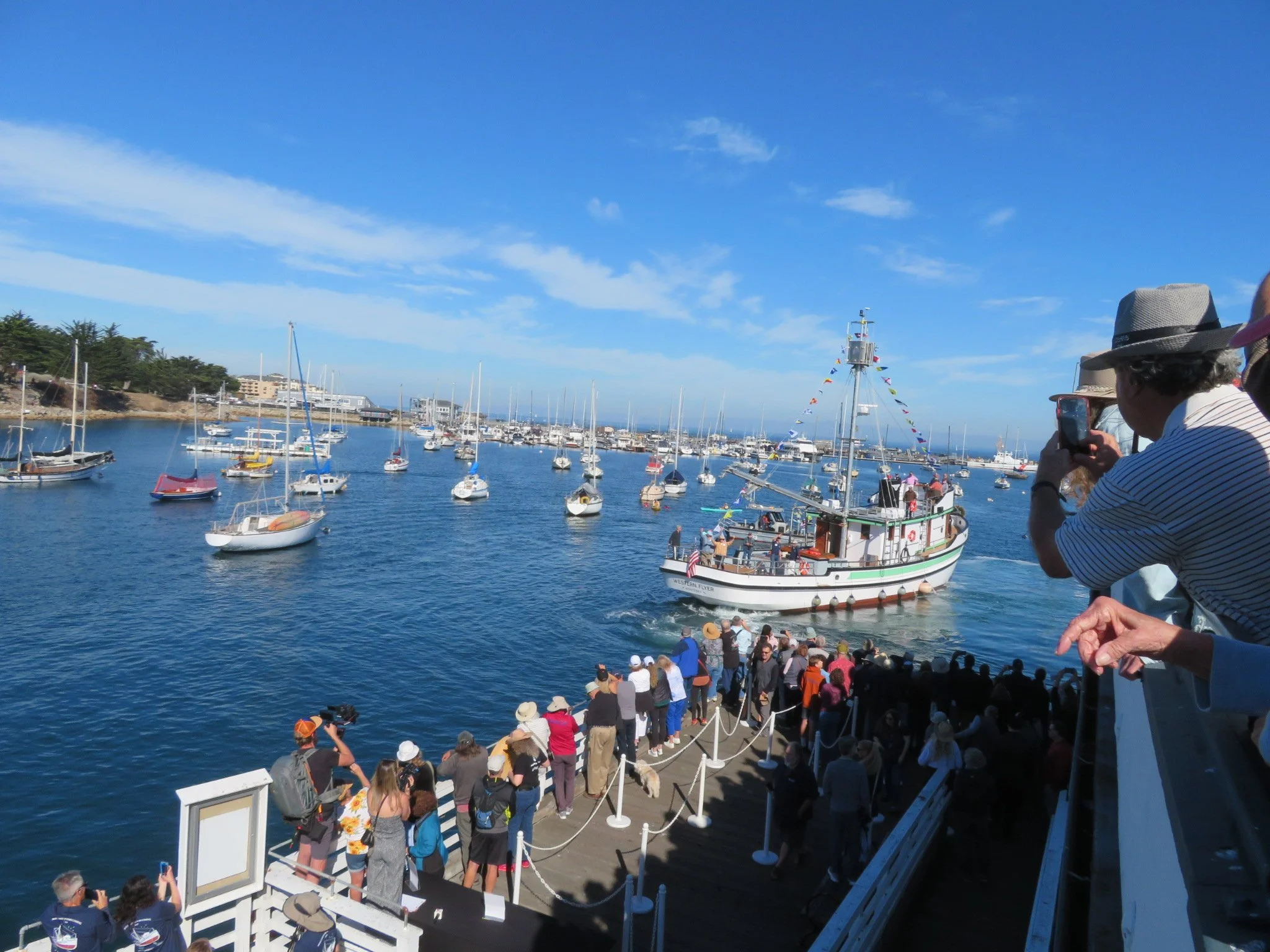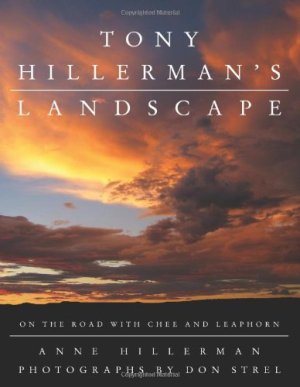Digging into deep connections between people and their stuff, Carolyn Handler Miller compares John Steinbeck's Western Flyer to her Subaru Impreza. Reflecting on shared journeys, breakdowns, and revivals, the article culminates in the poignant homecoming of the Western Flyer to Monterey, CA.
All in Literary Travel
Dragon’s Blood, Books, and Dance in Barcelona
Barbara Wysocki celebrates Catalonia's patron saint in Barcelona on a day that also recognizes a noble dragonslayer and marks the deaths of two literary lions. With a potpourri of bookish events, roaming musicians, and a chance to dance, she gets swept into the magic of past and present.
My Book, Your Life
by Nancy King
It was dark at 6 a.m. when I struggled to wake up so I could get ready to sell books. Would anyone care if I showed up or not? I was wondering what difference my books made in the world as I ate a hasty breakfast and drove to the farmer's market. Wishing I were still in my warm bed cuddling my cat, I set up my display and sat down at a table with three other authors, each of us trying to sell books to people as they passed by carrying bags of lettuce, tomatoes, and corn; they were interested in eating, not reading. Was the effort of writing a book worth it?
Just as I was thinking I’d rather sleep than try to sell books, a woman in her early fifties came up to me and said, “I’d like to buy one of your books. Which one do you recommend?”
“Tell me a little about yourself,” I said.
I’m an author, Nancy King—no relation to Stephen King—but if I were, this story might be different. As it is, I travel to independent bookstores in nearby cities, each time hoping I will find a room full of people waiting to hear what I have to say about my new novel, Changing Spaces, and wanting to buy my books.
In one bookstore, a few people wander up to the display, pick up copies of my books and thumb through the pages. This is promising, I think. There aren't many people, but at least looking and thumbing are a prelude to buying. I grin broadly when a petite, well-dressed woman approaches me. “Are you the author?”
Falling in Love with Wells Cathedral
by Elyn Aviva
I never thought I’d fall in love again. And certainly not with a building! Yet there I was, heart pounding, eyes damp at the sight of her.
Funny how the first few times I’d seen her, I never felt this “hit” of passionate connection. But that’s often how love strikes us, isn’t it? Not much interest at first—but then, Pow! Like a thunderbolt.
If I’d gotten a fortune cookie yesterday, it would have read: ‘Overconfidence brings misfortune.’ Or maybe, ‘Stay close to home today.’
Lacking such foresight, I was feeling cheerful about the two little flights – each less than 4 hours – that would take me from Florida to Arizona. This trip was trivial compared to the one from LAX to Melbourne: 16 hours in the air, which I do several times a year.
 I barely even packed. In my carryon, I had just a computer, wallet, and paperback – Anne Frank’s Diary of A Young Girl, which I was reading for the first time.
I barely even packed. In my carryon, I had just a computer, wallet, and paperback – Anne Frank’s Diary of A Young Girl, which I was reading for the first time.
A friend dropped me at sweet little Sarasota/Bradenton airport exactly 90 minutes before my 1.34 p.m. flight. But at the Delta counter, I heard a staff member apologizing to another customer: our flight was delayed at least an hour.
Over the PA, an agent made the unsmiling declaration that that Atlanta airport was opening and closing all day, due to “weather,” and that if we made it there during a brief open period, we’d probably be spending the night there, not getting on to our final destinations. That, or we could go home and start again tomorrow.
I had booked a “calming facial” the next morning at the Royal Palms Spa, and I needed it. My pores were clogged from months in the sun, and relaxing in the hands of a competent, smooth-skinned aesthetician would make this trip worthwhile.
The flight to Atlanta kept being further delayed, in maddening, twenty-minute increments, which meant there wasn’t time to go to Starbucks or watch the soothing tropical fish display. We finally boarded about 3.30 p.m., and I strapped myself in and sat reading Anne Frank’s Diary. Having never read the book before, I’d assumed it would be horrifically depressing, but in fact her journal was amusing and the narrator almost incredibly cheerful, as in this observation shortly after her family went into hiding.
words + photos by Linda Ballou
As I trotted behind my guide along the trails that Jack London once rode, I imagined myself as one of the many friends he led on horseback rides through his 1,400-acre Beauty Ranch in the early 1900s. We galloped through stands of eucalyptus, madrona, and towering redwood trees that shaded fern-filled glens just as Jack described them in his novel The Valley of the Moon.
 Delighted with each new vista I, too, felt “vitalized, organic” as I overlooked vineyards in their tidy rows stretching to the foot of the purple Sonoma Mountains. We cantered over a rise to see the lake that Jack and Charmian, his wife of eleven years, swam in on sunny afternoons. I saw myself gliding with them through the clear water then drying on a hot rock in the sun, cooled by the wisp of a breeze.
Delighted with each new vista I, too, felt “vitalized, organic” as I overlooked vineyards in their tidy rows stretching to the foot of the purple Sonoma Mountains. We cantered over a rise to see the lake that Jack and Charmian, his wife of eleven years, swam in on sunny afternoons. I saw myself gliding with them through the clear water then drying on a hot rock in the sun, cooled by the wisp of a breeze.
Like young Jack London, I went from California to the Northwest while in my teens. Unlike Jack, it was not my idea of a great adventure. My parents, determined to homestead in Haines, Alaska, rudely uprooted me and took me to a world populated by loggers, fishermen, and Tlingit Indians. At thirteen, I hadn’t read Jack’s White Fang or The Call of the Wild. I didn’t know I was walking in the famous author’s footsteps when I took the narrow gauge train that snakes up the Whitehorse pass into the Yukon. I had no idea it was the alternate route for the Chilkoot Trail Jack climbed carrying 150-pound pack during the Gold Rush of the 1890s.
A decade after my family’s shift to the North, Hollywood chose to use the more accessible Dalton Trail from Haines to the Klondike to re-enact the fabled climb of the stampeders up the ice steps of the Chilkoot Trail in the movie White Fang. Every able-bodied person in my hometown was hired to re-create the famous scene Jack described. Even then, while everyone in town swaggered about bragging about his or her role in the film, I still had no personal awareness of Jack London. He was simply an adventurer who captured the grit of the Northwest in children’s books.
In addition to nearsightedness and a deep sense of curiosity, my Dad and I shared a love of good stories. After his death two years ago, I had the opportunity to travel in his tire tracks. My road trip became a lesson in discovery, geographically and emotionally, showing me aspects of my father I had never seen and beautiful places I’d never visited. Ghosts have a creepy reputation, but my father’s made the perfect traveling companion.
Let’s start at the beginning. My Dad was Tony Hillerman. During his 35 years of writing best-selling mysteries, millions of fans treasured his stories of Navajo detectives solving crimes on the panoramic Navajo Nation. He also inspired me to start The Tony Hillerman Writers’ Conference, where he served as our most popular faculty member for several years.
Before Dad died in late October of 2008, my photographer husband Don Strel and I had launched our own book project, “Tony Hillerman’s Landscape: On the Road with Chee and Leaphorn” to show readers who had never been to Indian Country the settings in which the fictional Tribal Officers solved crimes. I gathered quotes from Dad’s books that described places where his detectives pause to comment on the scenery in Arizona, New Mexico, Utah and Colorado. Then we hit the road for Baby Rocks, Teec Nos Pos, Toadlena, Church Rock, Kayenta, Tsaile, Tuba City and other breathtaking places Dad loved.
Don and I finished the book with both relief and regret a few months after Dad died. We decided to promote it and honor my father’s memory with talks and slideshows to support public libraries. Little did I know that I would be getting most of the benefit, priceless stories from people in the audience whom my Dad had touched: loyal readers, distant relatives, Indian consultants, long-lost friends, and former co-workers and students from his days at the University of New Mexico.
At the small Placitas, N.M. library, a woman came up to me after my talk. “I have to tell you how I stalked your father,” she said. I was all ears.
Searching for Shakespeare
Venice. I was waiting for a traghetto gondola to ferry me across the Grand Canal when I spied a building plaque indicating that the palazzo in front of me was the home of Desdemona, the tragic heroine of Shakespeare’s “Othello.” I didn’t have time to check it out on that trip, but it fired my imagination and I did some research. Desdemona’s home is traditionally set at Palazzo Contarini Fasan, a private home, but now I must go back to see what I can of this home with the plaque. I’ve already been to the Doge’s Palace on Saint Mark’s Square, the Rialto Bridge and the Jewish Ghetto to breathe in the scenes of “The Merchant of Venice.”





